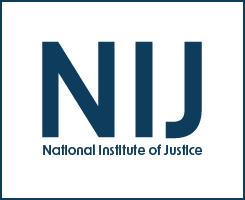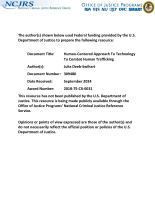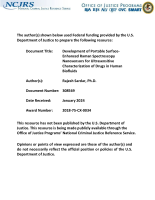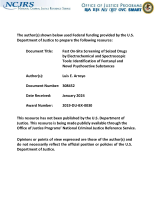Drug crime
Atwood Program, Lexington Federal Medical Center
Day-to-Day Criminality of Heroin Addicts in Baltimore - A Study in the Continuity of Offense Rates
ANTICIPATING COMMUNITY DRUG PROBLEMS: EXECUTIVE SUMMARY
Tapestry Program
Non-Contact Detection of Fentanyl and Other Opioids: Towards a Generalized Approach to Detection of Dangerous Drug Classes
Race and Rationality Revisited: An Empirical Examination of Differential Travel Patterns to Acquire Drugs Across Geographic Contexts
Assessing the Relationship between Immigration Status, Crime, Gang Affiliation, and Victimization
Offering Recovery Rather Than Punishment: Implementation of a Law Enforcement-led Pre-arrest Diversion-to-treatment Program for Adults with Substance Use Disorders
Development of Portable Surface-Enhanced Raman Spectroscopy Nanosensors for Ultrasensitive Characterization of Drugs in Human Biofluids
New Forensic Methods to Accurately Determine THC in Seized Cannabis
Fast On-site Screening of Seized Drugs by Electrochemical and Spectroscopic Tools: Identification of Fentanyl and Novel Psychoactive Substances
NIJ FY24 Research and Evaluation on Drugs and Crime: Money Laundering, Firearms, and Human Trafficking
Generating Highly Specific Spectra and Identifying Thermal Decomposition Products via Gas Chromatography / Vacuum Ultraviolet Spectroscopy (GC/VUV): Application to Nitrate Ester Explosives
Coinciding crises: The effects of the police legitimacy and opioid crises on the culture of a specialized drug investigation unit
Crime and Building Rehabilitation or Demolition: A Dose-Response Analysis
Decoding hidden darknet networks: What we learned about the illicit fentanyl trade on AlphaBay
Fine-grained Classification of Drug Trafficking Based on Instagram Hashtags
NIJ Awards $16M to Support Forensic Science Research
On September 26, 2023, NIJ announced $16 million in new funding to support 33 projects under the FY23 Research and Development in Forensic Science for Criminal Justice Purposes solicitation. Through this program, NIJ continues to advance the speed, accuracy, and reliability of forensic analysis, which ultimately bolsters the administration of justice.
Funding Highlights for Fiscal Year 2023
Since 2009, NIJ has invested nearly $300 million...
Optimizing Analytical Parameters for Detection of Chronic and Single Dose Drug Exposure in Forensic Hair Analysis
Developing a Portable and Fast Opioid Assessment Tool for Improved Field Decision-Making
Understanding the Scope and Nature of Forced Criminality in the United States
Inclusive Research: Engaging People Closest to the Issue Makes for Better Science & Greater Impact; 2023 NIJ Research Conference Plenary
This panel will discuss what inclusive research is, how to conduct it, and what issues and challenges exist about engaging in it. “Inclusive research” has its history as a participatory research method designed to ensure people closest to the issue or problem under study are authentically engaged in the research process rather than simply being “research subjects.” While community-based participatory research has begun to take on greater prominence in the criminal justice realm, such efforts are largely confined to qualitative research inquiries.
See the YouTube Terms of Service and Google Privacy Policy
2023 NIJ Research Conference Opening Ceremony
The theme of NIJ’s 2023 Research Conference was “evidence to action,” and our goal was to bring researchers and practitioners together to learn about the latest research evidence and how it can be implemented to promote safety, equity, and justice.
The opening ceremony included remarks from U.S. Attorney General Merrick B. Garland, Assistant Attorney General for the Office of Justice Programs Amy Solomon, and NIJ Director Nancy La Vigne.
See the YouTube Terms of Service and Google Privacy Policy





